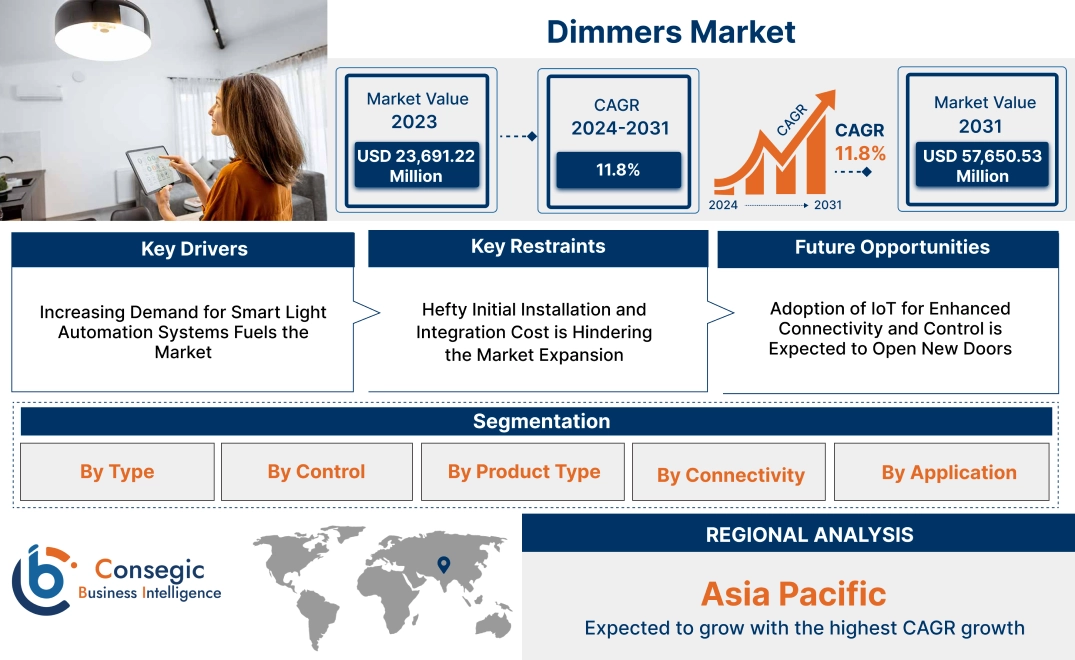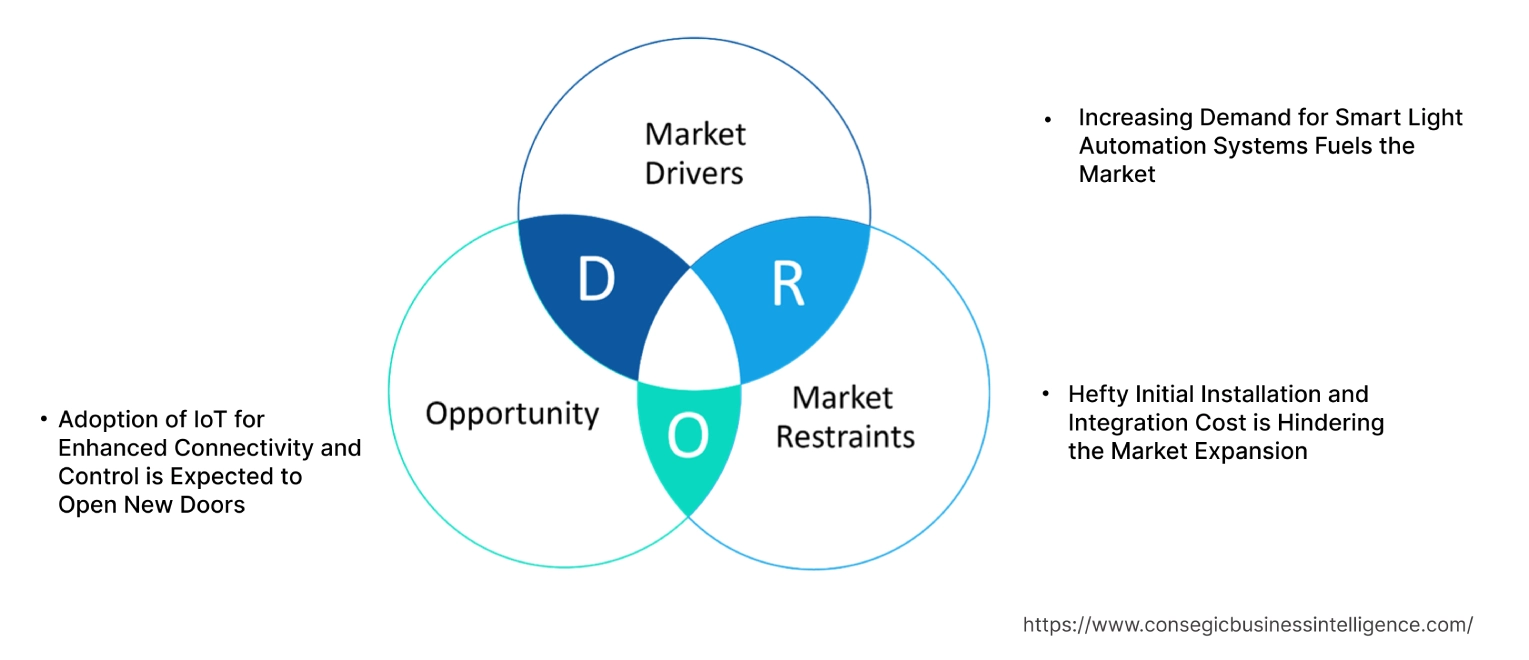- Summary
- Table Of Content
- Methodology
Dimmers Market Size:
Dimmers Market size is estimated to reach over USD 57,650.53 Million by 2031 from a value of USD 23,691.22 Million in 2023 and is projected to grow by USD 26,054.66 Million in 2024, growing at a CAGR of 11.8% from 2024 to 2031.
Dimmers Market Scope & Overview:
Dimmers are electronic devices that enable to adjustment of the brightness of lighting, by giving control over the ambiance and energy consumption. It provides a range of brightness levels, making it possible to soften or brighten the lighting as per the requirements. They work by reducing the amount of electrical current flowing to a light source, which lowers the brightness. Additionally, it enhances comfort by allowing users to tailor the lighting to their preference and energy efficiency by reducing the amount is electricity used. Moreover, advancements in dimmer technology make them versatile tools for smart automated systems of modern lighting management in homes, offices, and public spaces. The aforementioned benefits are major determinants for increasing their deployment in residential, commercial, and industrial settings.
Dimmers Market Insights:
Key Drivers:
Increasing Demand for Smart Light Automation Systems Fuels the Market
As smart home and building technologies advance, there is a growing drift of incorporating dimmers into lighting setups to gain precise control over brightness levels. These systems enable users to adjust lighting through mobile apps, voice commands, or automation schedules, enhancing convenience and energy efficiency. Additionally, this integration is crucial for creating customizable lighting environments that adapt to various needs and preferences. Moreover, the push towards energy efficiency and sustainability in modern construction and renovation projects further fuels the demand.
- In June 2023, URC released URC Lighting LT-3300 a smart lighting product designed for residential and commercial automation. This lighting enables the users to control and program the atmosphere with dimmers and switch configurations. It features auto load detection, touch control, trailing edge, colorful, customizable LED bars, reliable performance, and Z-wave networking.
Therefore, energy-efficient initiatives of smart lighting automated systems are driving the dimmers market growth.
Key Restraints :
Hefty Initial Installation and Integration Cost is Hindering the Market Expansion
The high initial costs associated with advanced dimming systems are the main key restraint in the market. This primary challenge can significantly impact market growth by limiting adoption, particularly in regions with budget constraints or in sectors where cost is a critical factor. Additionally, the upfront investment required for advanced, smart, and integrated dimming solutions can deter both residential and commercial customers, making it a substantial barrier to widespread market penetration. Moreover, the installation of advanced systems involves additional expenses, including professional installation services and compatibility adjustments. Furthermore, integrating with existing home automation or building management systems is complex and costly. The need for compatibility with other smart devices or infrastructure adds to the overall expense. Hence, the overall expense of installation and integration cost is a significant barrier to the dimmers market demand.
Future Opportunities :
Adoption of IoT for Enhanced Connectivity and Control is Expected to Open New Doors
The shift towards the adoption of wireless connectivity and IoT devices presents opportunities for the development of advanced wireless dimmers. The integration of these devices with IoT devices enables enhanced connectivity and control. IoT-enabled dimming devices communicate with various smart devices within a home or building, allowing for seamless operation through centralized control hubs or mobile apps. Additionally, this connectivity facilitates remote operation and monitoring, making it easier for users to adjust lighting settings from anywhere through apps controlled by mobile devices.
- In November 2021, Lutron unveiled RadioRA 3 Lighting Control System which includes SUNNATA RF keypads, dimmers, and switches. It features IoT connectivity powered by Power over Ethernet (PoE), and app-based editing. This connectivity enables users to control the lighting systems through the Lutron app, voice assistant, remote, or wall control. It offers enhanced connectivity, seamless control, and automation capabilities.
Furthermore, IoT-enabled dimming devices collect and transmit data on lighting usage and energy consumption. This data analysis is used to provide insights into lighting patterns, helping users make informed decisions about their lighting needs and identify opportunities for further energy savings.
Consequently, according to the analysis, integration with IoT opens up for the dimmers market opportunities to create more intelligent, responsive, and energy-efficient lighting systems.
Dimmers Market Segmental Analysis :
By Type:
Based on type the market is segmented into halogen and incandescent dimmers, electronic low voltage dimmers (ELV), magnetic low voltage dimmers (MLV), fluorescent dimmers, and high wattage dimmers.
Trends in the Type:
- High-wattage dimmers designed to handle heavy-duty lighting systems including theaters, stadiums, or very large event spaces, remain essential in specialized applications. There has been a drift towards incorporating energy-efficient solutions even in high-wattage settings.
- MLV dimming devices used with low-voltage lighting systems including track or recessed lighting, are gradually being replaced by ELV dimmers as low-voltage systems shift towards LED technology.
The electronic low voltage dimmer (ELV) accounted for the largest revenue share in the year 2023 and is anticipated to register the fastest CAGR during the forecast period.
- Electronic dimmers are highly compatible with energy-efficient LED lighting systems, which have become the standard in both residential and commercial.
- These offer smooth, flicker-free, dimming, providing a better user experience with modern lighting technologies.
- Additionally, these are often used in smart lighting systems, making them popular in buildings that incorporate automation and IoT devices.
- In March 2023, Crestron introduced Horizon keypads and dimmers designed to enhance the functionality of buildings. It is designed to feature improved color, finish, and alignment in visually appealing layouts and enable the color temperature of the backlight adjustment.
- Thus, the modern light technologies of electronic low-voltage dimming devices are fueling the dimmers market share.
By Control:
Based on control the market is segmented into single-pole dimming, three-way dimming, several or multi-location dimming, and plug-in dimming.
Trends in the Control:
- There is a growing drift toward integrating single-pole dimming devices with smart home systems. This allows users to control lighting remotely via mobile apps and voice commands, enhancing convenience and functionality.
- Modern three-way dimming devices are incorporating advanced features such as scene setting and scheduling. These functionalities allow users to create customized lighting environments and automate lighting changes based on the time of day or activities.
The single-pole dimming accounted for the largest revenue share in the year 2023
- Single pole dimming controls are devices used to adjust the brightness of lighting from a single switch or control point.
- These devices allow users to adjust the light intensity by turning a knob, sliding a lever, or using a touch-sensitive interface.
- Features of single pole dimming are single point control, enhanced dimming functionality, simple installation, and compatibility.
- For instance, Legrand introduced Radiant Single Pole Dimmer, featuring a modern design and easy-to-use controls. It integrates with Legrand's smart home systems and provides smooth dimming for a variety of light sources.
- Overall, single-pole dimming devices offer a simple yet effective solution for adjusting lighting levels in various settings, propelling the market.
The multi-location dimming is anticipated to register the fastest CAGR during the forecast period.
- Multi-location dimming enables control of the light fixture from different locations.
- It offers enhanced convenience and is becoming popular in larger homes and commercial spaces, allowing lights to be controlled from different locations remotely through apps or voice commands.
- In March 2021, Leviton expanded its Decora Smart Dimmer series with multi-location dimming functionality. The new dimming devices are designed for homes using Leviton's smart lighting ecosystem and support control via the Leviton app which is compatible with Google Assistant, and Amazon Alexa.
- Hence, the compatibility, flexibility, and convenience of controlling the lighting systems remotely are driving the market.
By Product Type:
Based on product type the market is segmented into product, slide, rotary, toggle, touch, tabletop, and others.
Trends in the Product Type:
- Tabletop dimming devices are increasingly being designed with smart technology, enabling users to control lighting from a mobile app via voice commands.
- Product dimming devices, often specialized or integrated into lighting products themselves, are being developed with advanced features like automatic adjustment and ambient light detection.
The slide dimmer accounted for the largest revenue of the dimmers market share in 2023.
- Slide dimmer is a type of lighting control device that allows users to adjust the brightness of lights by moving a sliding lever or button up or down.
- These provide smooth, continuous control, making it easy to dim or brighten lights to the desired level.
- Features of slide dimmer include precision in light control, smart integration, ease of use, customization options, and versatility.
- For instance, Leviton's 6672-1LW SureSlide Dimmer Switch for Dimmable LED. It features 150W LED, 600 W incandescent/halogen, 60Hz, and single pole installation. It is designed to provide easy installation, convenience in controlling, enhanced compatibility, and customization.
- Hence, precision in lighting and compatibility of the slide dimmer are boosting the dimmer's market share.
The touch dimmer is anticipated to register the fastest CAGR during the forecast period.
- Touch dimming devices are advanced lighting control devices that adjust light levels through a touch-sensitive interface.
- These dimmer uses a flat, touch-responsive surface that allows users to increase or decrease brightness with a simple touch or swipe.
- Additionally, it is increasingly being designed with advanced smart home compatibility, enabling users to control lighting through mobile apps and voice commands, which aligns with the growing trend of home automation.
- In January 2023, Synaptics unveiled SmartBridge SB7900 local dimming IC. This dimmer enables larger, high-contrast, and higher-resolution automotive touch displays. It is incorporated with an AEC-Q100 Grade 2-qualified solution which works with Synaptics' lineup of touch and display drivers to provide an automotive-grade solution.
- Thus, advancements in touch-dimming devices promote potential prospects for dimmers market trends.
By Connectivity:
Based on connectivity the market is segmented into wired and wireless.
Trends in the Connectivity:
- There is a shift towards integrating wired dimming devices with building management systems and other infrastructure. This integration allows for centralized control and automation of lighting in commercial and industrial settings.
- Wireless dimming devices are rapidly gaining popularity due to their compatibility with smart home systems. They support remote control via mobile apps, voice assistants, and automation platforms, making them a key component in modern smart homes.
The wired connectivity accounted for the largest revenue in 2023 of the global dimmers market.
- Wired dimmer is preferred for their reliability, and consistent performance, and are less prone to interference and signal issues.
- Many existing buildings and infrastructure are already equipped with wired systems, which makes wired dimming devices a natural fit for upgrades and replacements.
- For instance, Lutron introduced HomeWorks Wired Maestro Dimmers, which is utilized in localized and customized lighting control designs. It has an integral microprocessor which enables it to be incorporated with a whole-house lighting control system.
- Therefore, consistent performance and reliability of wired connectivity are driving the dimmers market growth.
The wireless connectivity is anticipated to register the fastest CAGR during the forecast period.
- Wireless dimming devices are increasingly favored due to their compatibility with smart home ecosystems.
- Their ability to integrate with voice assistants, mobile apps, and home automation systems makes them a preferred choice for modern smart homes.
- Additionally, wireless connection technologies including Bluetooth, Zigbee, Z-Wave, and Wi-Fi are enhancing performance and reliability by providing improved connectivity and long-range control.
- In February 2022, Fluence launched Wireless Flex Dimming with Bluetooth mesh technology as a new addition to its lighting control portfolio. This enables Fluence luminaires to dim light levels wirelessly using any industry-standard 0-10V dimmer or environmental controller. It features easy installation, cost cost-effective solution, and enhanced control with mobile apps to scale operation remotely.
- Hence, the analysis shows that improved connectivity and longer-range control are increasing the adoption of wireless connectivity, boosting the dimmers market trends.
By Application:
Based on application the market is segmented into residential, commercial, and industrial.
Trends in the Application:
- In commercial spaces, there is a drift towards sophisticated lighting control systems that integrate dimming devices with building management systems. This integration allows for centralized control and automation, optimizing energy use and improving the work environment.
- Industrial applications are seeing a trend towards integrating dimming devices with automation systems. This integration allows for precise control of lighting in complex industrial environments, improving efficiency and safety.
The residential segment accounted for the largest revenue of 57.27% in the year 2023 and is anticipated to register the fastest CAGR during the forecast period.
- The increasing adoption of smart home technologies drives the demand for the residential industry. Homeowners are seeking integrated solutions that offer convenience, energy savings, and enhanced control over their lighting systems.
- Residential spaces are placing a strong emphasis on energy-efficient solutions. Dimming devices are popular for their ability to reduce energy consumption and extend the lifespan of light bulbs, making them a favored choice in home settings.
- Additionally, customizable lighting options enhance home environments by personalizing their living space.
- In September 2022, applications. The smart dimmer offers simplicity, flexibility, and customization to enable homeowners to deliver the best lighting experience by providing enhanced control.
- Consequently, these factors contribute to the dominance of residential applications in the dimmers market.
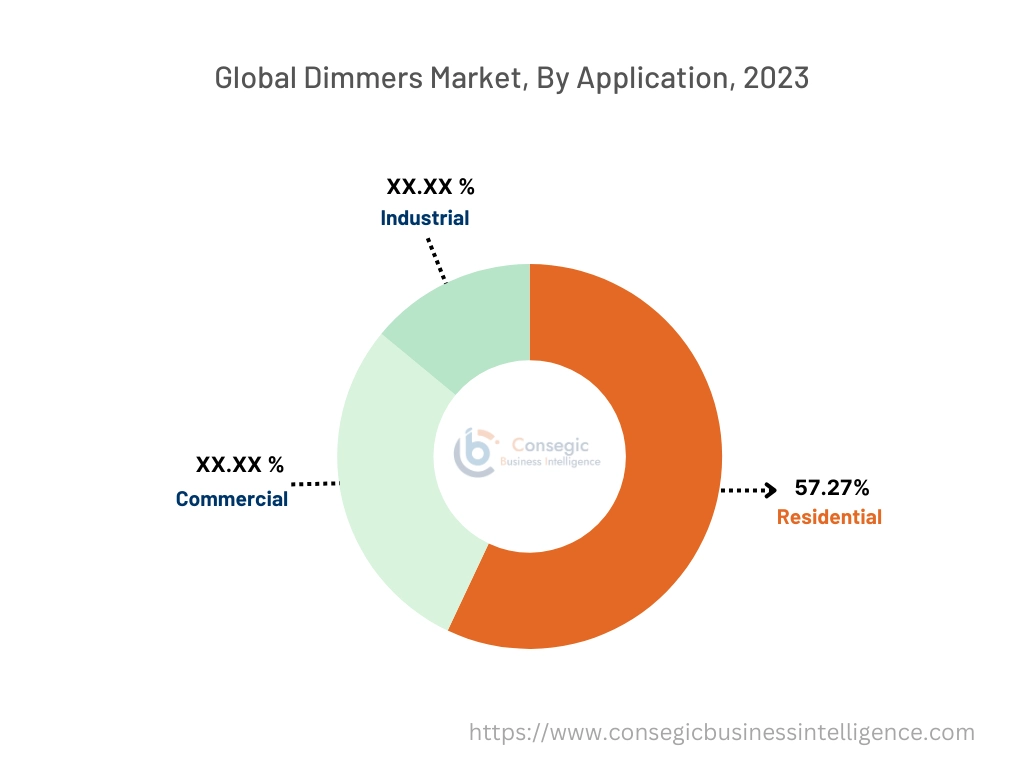
Regional Analysis:
The regions covered are North America, Europe, Asia Pacific, the Middle East and Africa, and Latin America.
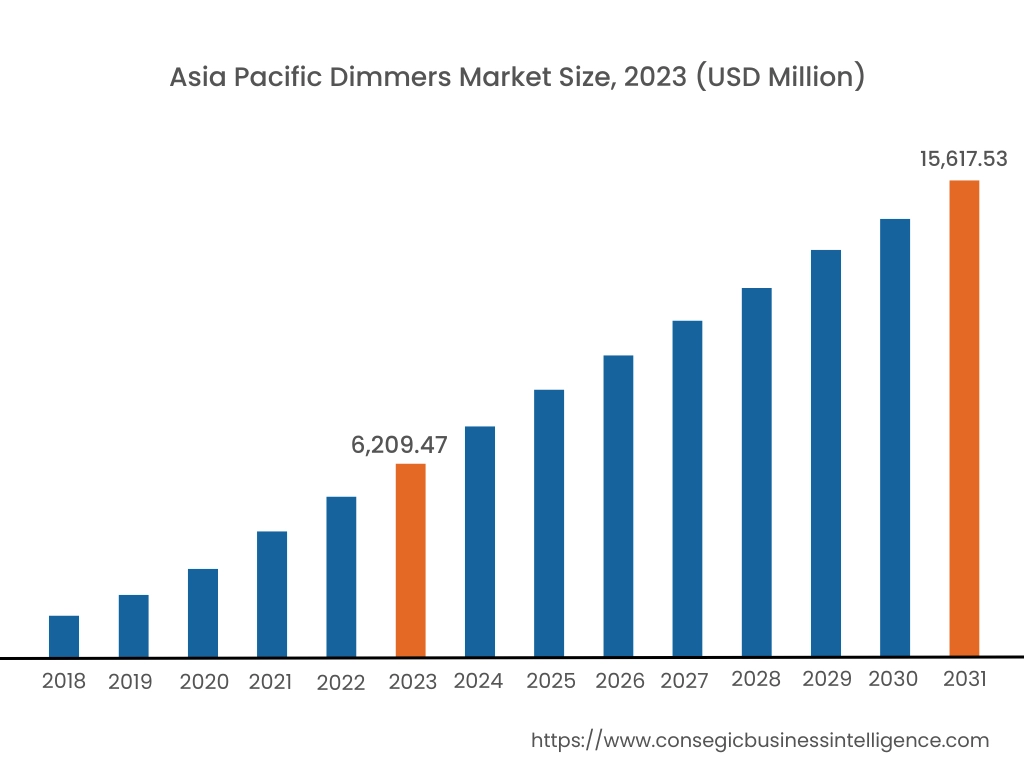
Asia Pacific region was valued at USD 6,209.47 Million in 2023. Moreover, it is projected to grow by USD 6,848.03 Million in 2024 and reach over USD 15,617.53 Million by 2031. Out of this, China accounted for the maximum revenue share of 27.1%. According to the dimmers market analysis, the Asia-Pacific region is rapidly emerging due to rapid urbanization and industrial growth. Countries including China and India are leading the expansion with substantial investments. Additionally, there is a growing trend towards the adoption of wireless and smart dimming devices in both residential and commercial sectors. The demand for energy-efficient solutions and modern lighting control systems is on the rise.
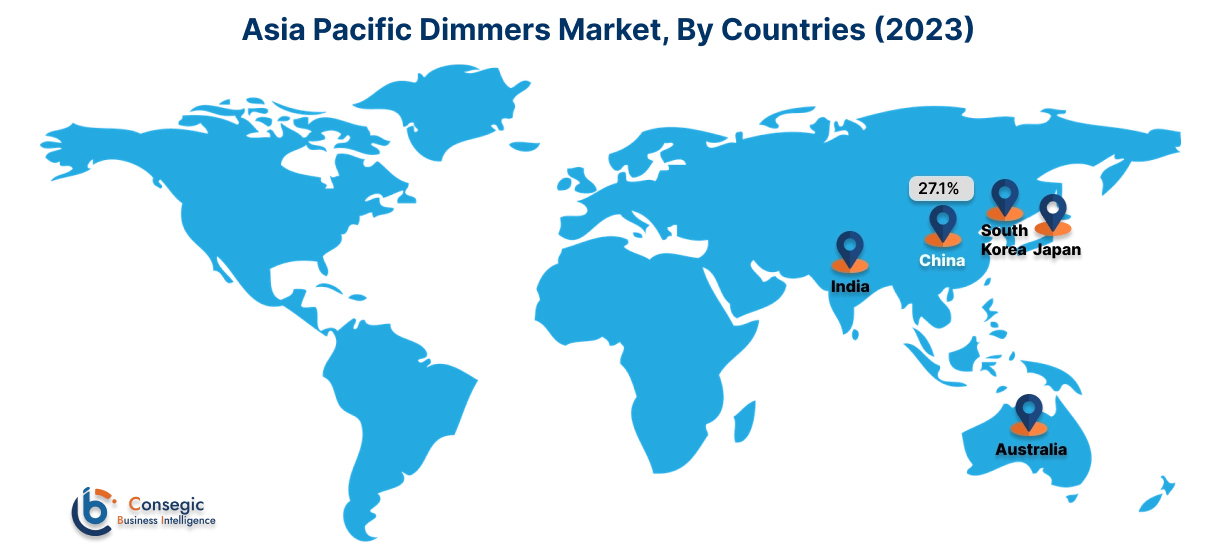
North America is estimated to reach over USD 19,474.35 Million by 2031 from a value of USD 8,087.59 Million in 2023 and is projected to grow by USD 8,886.65 Million in 2024. North America, particularly the United States, remains the leading region in the market, driven by advanced infrastructure and a high adoption rate of smart home technologies. The region's robust regulatory framework supporting energy efficiency, combined with significant investments in smart lighting solutions, propels the market forward. Moreover, the increasing focus on energy conservation, coupled with the proliferation of smart home platforms, contributes to the region's dominance and continuous growth in the market.
- In July 2024, Leviton (US) launched Decora Smart Wi-Fi ELV/LED Phase-Selectable Dimmer (D2ELV). This dimmer provides enhanced lighting control and performance for residential applications at a cost-effective price. The Decora Smart seamlessly integrates with smart home platforms including Amazon Alexa, Google Assistant, Samsung SmartThings, and Apple Home.
Europe is a key player in the global dimmers market, fueled by a strong emphasis on sustainability and regulatory policies that promote energy-efficient technologies. The continent's significant investments in smart cities and green infrastructure drive demand for advanced dimming solutions.
Latin America is experiencing promising growth in the market, driven by expanding infrastructure projects and a rising middle class. Nations including Brazil and Mexico are witnessing increased investments in smart technologies.
The Middle East and Africa region is beginning to show growth in the market, with increased focus on large-scale infrastructure projects and urbanization. The region's emphasis on energy efficiency and sustainability is fostering a growing interest in advanced dimming.
Top Key Players & Market Share Insights:
The dimmers market is highly competitive with major players providing controlled lighting systems to the national and international markets. Key players are adopting several strategies in research and development (R&D), product innovation, and end-user launches to hold a strong position in the dimmers market. Key players in the dimmers industry include-
- Lutron Electronics Co., Inc. (USA)
- Leviton Manufacturing Co., Inc. (USA)
- Schneider Electric SE (France)
- Hubbell Incorporated (USA)
- Signify Holding (Netherlands)
- Eaton Corporation (Ireland)
- ABB Ltd. (Switzerland)
- Honeywell International Inc. (USA)
- Siemens AG (Germany)
- Crestron Electronics, Inc. (USA)
Dimmers Market Ecosystem:
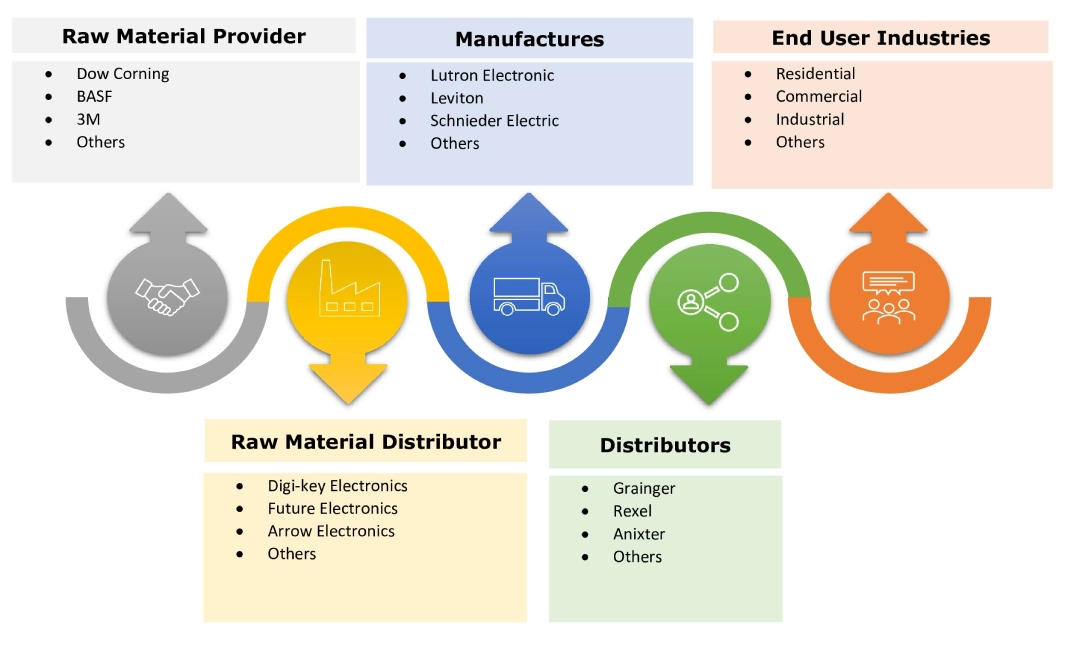
Recent Industry Developments :
Product Expansions:
- In August 2024, Lutron Electronics expanded its Caseta portfolio by launching the Diva smart dimmer with ELV+ technology and Pico paddle remotes. This offers smart control for low-voltage applications and physical control to deliver a smoother dimming experience.
- In June 2024, Leviton expands the Decora Smart Z-Wave Plus Line with a New 800-Series Switch and Dimmer. The series is compatible with the Z-wave network to ensure interoperability with Z-wave hubs and security systems, including Samsung SmartThings, Ring Security, Alarm.com, and Home Assistant. This offers users with safe, secure smart home experience and advanced lighting control.
Product Launch:
- In February 2024, Hamilton unveiled an LEDSTAT Smart Wi-Fi Dimmer for controlling lights around residential and commercial spaces. It offers easy installation, enhanced comfort, energy efficiency, and convenience along with Alexa control.
Dimmers Market Report Insights :
| Report Attributes | Report Details |
| Study Timeline | 2018-2031 |
| Market Size in 2031 | USD 4,461.86 Million |
| CAGR (2024-2031) | 37.4% |
| By Type |
|
| By Control |
|
| By Product Type |
|
| By Connectivity |
|
| By Application |
|
| By End-User |
|
| By Region |
|
| Key Players |
|
| North America | U.S. Canada Mexico |
| Europe | U.K. Germany France Spain Italy Russia Benelux Rest of Europe |
| APAC | China South Korea Japan India Australia ASEAN Rest of Asia-Pacific |
| Middle East and Africa | GCC Turkey South Africa Rest of MEA |
| LATAM | Brazil Argentina Chile Rest of LATAM |
| Report Coverage |
|
Key Questions Answered in the Report
How big is the dimmers market? +
Dimmers Market size is estimated to reach over USD 57,650.53 Million by 2031 from a value of USD 23,691.22 Million in 2023 and is projected to grow by USD 26,054.66 Million in 2024, growing at a CAGR of 11.8% from 2024 to 2031.
What is dimmers? +
Dimmers are electronic devices that enable to adjustment of the brightness of lighting, by giving control over the ambiance and energy consumption. It provides a range of brightness levels, making it possible to soften or brighten the lighting as per the requirements.
What is the key market trend? +
The solid-state dimmer is growing rapidly with the trend towards home automation. These dimmers are easily integrated with IoT systems, offering remote control, voice commands, and app-based functionality.
Who are the major players in the dimmers market? +
The key players in the dimmers market are Lutron Electronics Co., Inc. (USA), Leviton Manufacturing Co., Inc. (USA), Eaton Corporation (Ireland), Schneider Electric SE (France), Hubbell Incorporated (USA), Signify Holding (Netherlands), Honeywell International Inc. (USA), Siemens AG (Germany), Crestron Electronics, Inc. (USA), ABB Ltd. (Switzerland) and others.
